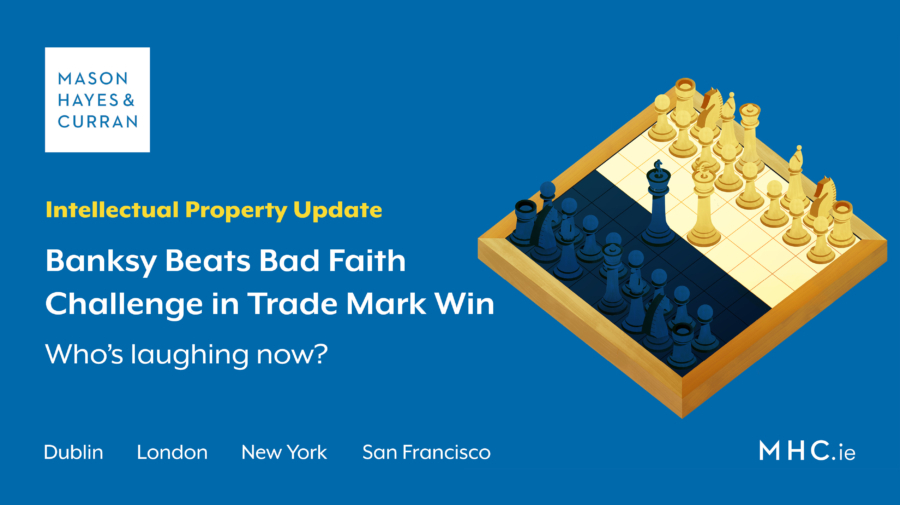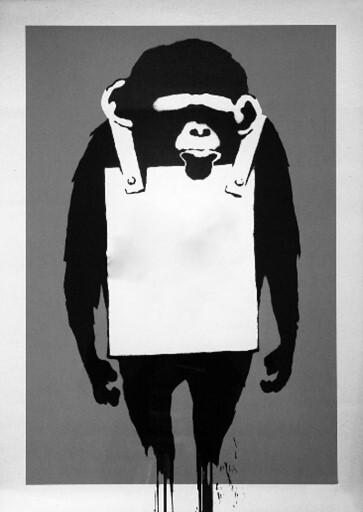
The English street artist Banksy has been no stranger to trade mark disputes in recent years. In the most recent EUIPO decision on the matter, Banksy had a major win as his ‘Laugh Now’ trade mark was successfully defended and maintained by the EUIPO. Our Intellectual Property team analyse the decision.
We previously reported on a trade mark invalidity dispute involving the famous English street artist Banksy’s flower thrower trade mark. In a more recent development, Banksy’s ‘Laugh Now’ trade mark registration has survived a similar attack by the same third party. In finding in favour of Banksy and in upholding the ‘Laugh Now’ trade mark registration on this occasion, the EUIPO Fifth Board of Appeal provided helpful guidance on EUIPO cancellation applications based on bad faith. On the whole, the decision serves as a reminder of the interplay between copyright and trade mark protection and how both protections can apply to the same piece of artwork. We analyse the decision and its impact.
Background
In 2018, Pest Control Office Limited who are the legal representatives of Banksy, applied to register the figurative mark below for a wide range of goods. These included clothing and games in classes 9, 16, 25 and 28, and services such as entertainment services and art exhibition services in class 41.

The trade mark, which is based on Banksy’s ‘Laugh Now’ street art, was registered in June 2019. Later that year, Full Colour Black Limited applied for the trade mark to be declared invalid, on the basis that it had been filed in bad faith.
Bad faith challenge
Full Colour Black submitted that Banksy cannot gain rights from the trade mark because it was filed in bad faith. In particular, it argued that if Banksy wanted to protect the sign under copyright law this would require him to lose his anonymity which would in turn undermine his persona. It was clear, according to Full Colour Black, that at the time of filing the EUTM application, Banksy did not intend to use the mark as actual use of the trade mark was only made approximately one month prior to the filing of the cancellation action proceedings. This use, it argued, was solely to circumvent the requirements of trade mark law and therefore there was no intention by Banksy to genuinely use the sign as a trade mark. Full Colour Black argued that Banksy’s actions were inconsistent with honest practices. For consistency with the EUIPO decision in the Flower Thrower case, Full Colour Black contended that this application should also be held to have been filed in bad faith.
Cancellation Division decision
The EUIPO Cancellation Division accepted Full Colour Black’s arguments. It found that that the mark had been filed in bad faith by Banksy because it was filed without a genuine intention to use it as a trade mark. The Cancellation Division also deemed that it was filed to circumvent the law of copyright. Banksy appealed the decision to the EUIPO Board of Appeal.
Appeal
The EUIPO Fifth Board of Appeal ultimately reversed the Cancellation Division’s decision and found in favour of Banksy. Taking all the facts and circumstances into account, it concluded that it had not been shown that Banksy lacked any intention to use the trade mark at the filing date. In particular, it pointed out that the five year grace period had not yet ended. This aspect weighed strongly in favour of good faith on Banksy’s part and it had not been rebutted by Full Colour Black. In addition, the Board held that:
- The same piece of artwork could be protected as an original creative work by copyright and as an indicator of commercial origin by trade mark law. The existence of copyright is not an obstacle for trade mark protection to also apply.
- The sign is a figurative mark and therefore although it is an artwork, it could also be registered as a trade mark.
- The sign consists of an unusual combination of elements. The ape is wearing a white label, for example, which is quite striking and will be kept in mind by consumers.
More specific to the question of bad faith, it found that:
- The intention of a trade mark applicant is a subjective factor which must be determined objectively and must be the subject of an overall assessment, taking into account all the factual circumstances relevant to the particular case.
- The fact that Banksy had opted for trade mark protection as a more efficient means of protecting his artwork rather than copyright, did not show that he was not willing to use the mark when it was filed.
- According to the case law, an EUTM owner does not need to know at the date of filing when she/he will start to use the trade mark. For that purpose, there is a 5-year grace period granted; and
- The fact that the artwork had been made public permitting its copy and use and also the fact that certain third parties had used it as decorative features on their merchandising goods does not indicate any lack of intention to use the mark at the time of filing the application.
Comment
The Board of Appeal decision undoubtedly represents a win for Banksy and is in stark contrast to the decision reached in the Flower Thrower case. Indeed, the Board of Appeal went as far as to suggest that rather than Banksy’s actions amounting to an abuse of the trade mark system, there is a “certain commercial logic” in the owner of a copyright seeking to protect his creation also as a trade mark. This will be welcome news to other artists and creators of visual content who may now wish to seek trade mark protection for their artwork.
Overall, the decision provides a reminder of the difficulties associated with establishing that there has been bad faith on the part of a trade mark applicant at the time of filing an application. Finally, whether or not this latest decision represents the end of all trade mark disputes between Banksy and Full Colour Black seems unlikely but remains to be seen.
For more information and expert advice on protecting your organisation's intellectual property rights, contact a member of our Intellectual Property team.
The content of this article is provided for information purposes only and does not constitute legal or other advice.
Share this:






